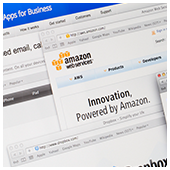 Are you making the most of one of your business’s greatest assets? Along with your loyal customers, your team of enthusiastic and hardworking staff, and your tastefully decorated store or office, there is an all-too-often-unsung hero just waiting to help you take your business to the next level: your data. You’ve probably read articles extolling the virtues of data mining, but just how does a small or medium-sized organization actually use data to grow their business?
Are you making the most of one of your business’s greatest assets? Along with your loyal customers, your team of enthusiastic and hardworking staff, and your tastefully decorated store or office, there is an all-too-often-unsung hero just waiting to help you take your business to the next level: your data. You’ve probably read articles extolling the virtues of data mining, but just how does a small or medium-sized organization actually use data to grow their business?
Many small and medium-sized businesses shy away from data analytics due to the perceived complexities of dealing with the myriad of facts and figures. A head for figures is something many of us lack – and, even if you have no problem with the math, there’s the time involved in setting aside a part of your busy schedule to track your analytics.
But the sooner you embrace your data, the sooner you can start adding real value to your business through this extremely valuable, and often untapped, source. But just how does a smaller enterprise actually set about doing that? After all, even the most humble of mom and pop stores or home-office-based entrepreneurs has access to an often bewildering array of trackable metrics.
The key point is that, if data is to be of any value, it needs to be easy to collect, collate and analyze. There’s no point spending half your working week mired in incomprehensible spreadsheets and charts if you can’t extract useful information and then apply it in a meaningful way that meets your end goals.
When thinking about analytics, it can be easy to feel overwhelmed. Not only that, but the vast majority of business owners would much rather spend their working lives filling dental cavities, laying flooring, solving legal disputes or selling fitted kitchens – whatever your own particular specialist skill might be – than learning about and trying to apply data analysis techniques. That’s where an analytics dashboard can help. These take the hassle out of unearthing all that data, and present your metrics to you in a more understandable format. But with an array of different tools to choose from, what should you consider if this is the route you decide to take?
- How easy is it to use? There’s no point investing in a dashboard solution if you don’t understand the way the data is presented to you; you still won’t be able to apply it in any meaningful way.
- How deep will the analysis go? You’ll likely want to be able to track trends, compare results over time, and chart your success.
- Is the data easy to apply? You want your dashboard to simplify the application of data within your business environment, and make it easy for you to take action.
- Does it save you time? If you’re currently spending frustrating hours sifting through reams of facts and figures, this is a huge consideration. You need your dashboard to supply pertinent information in an easy-to-read format.
- Is it compatible with other programs and apps? If you’re operating an online store, you will want the dashboard to work with your POS and shopping cart. You may also want it to track website analytics and social media engagement.
Once you’ve decided on a data analytic dashboard, how do you know which metrics to look at? Every business will differ depending on their industry and individual needs or challenges, but there are a couple of points you will want to bear in mind.
Look for data trends
To make the leap from looking at data to making plans and actually doing something, you need to highlight your most important metrics and use them as something to action. Let’s say you find it hard to retain customers; you know this and your data backs it up. Clearly you’re not doing enough to ensure your customers return. That could indicate you’re spending too much time and money on attracting new clients. Now you can take action: do you need to improve your customer service or offer more products or services? Create a marketing plan that targets past customers by telling them about something new or by offering them a discount.
Analyze your past customers
Now you have easy access to data that shows you your best selling products or services, your peak selling periods, and more. This will help you get to know your customers far better, track their behavior, and plan ahead when it comes to adding services, buying inventory, or preparing for busy spells.
Whether your aim is to attract new customers, retain old ones, expand your offering, or discern whether opening a new location is a viable option, your data will prove to be an indispensable friend. After all, customers may come and go – but your data will always be there for you.
If you’d like to learn more about adding value to your business with data analysis, or want to explore data analysis dashboard options, get in touch with us today – we’ll be happy to advise you on the options best suited to your needs.
 Recently, Amazon Web Services (AWS) announced the creation of a new data analytics tool to lighten the burden on businesses when analyzing data in the cloud. This tool, referred to as “Glue,” is meant to clean up and organize data that comes into the cloud from various sources so that it can be analyzed by business intelligence software and data analytics experts. Let’s take a closer look at this service and how it can benefit you and your business.
Recently, Amazon Web Services (AWS) announced the creation of a new data analytics tool to lighten the burden on businesses when analyzing data in the cloud. This tool, referred to as “Glue,” is meant to clean up and organize data that comes into the cloud from various sources so that it can be analyzed by business intelligence software and data analytics experts. Let’s take a closer look at this service and how it can benefit you and your business.


 Are you making the most of one of your business’s greatest assets? Along with your loyal customers, your team of enthusiastic and hardworking staff, and your tastefully decorated store or office, there is an all-too-often-unsung hero just waiting to help you take your business to the next level: your data. You’ve probably read articles extolling the virtues of data mining, but just how does a small or medium-sized organization actually use data to grow their business?
Are you making the most of one of your business’s greatest assets? Along with your loyal customers, your team of enthusiastic and hardworking staff, and your tastefully decorated store or office, there is an all-too-often-unsung hero just waiting to help you take your business to the next level: your data. You’ve probably read articles extolling the virtues of data mining, but just how does a small or medium-sized organization actually use data to grow their business?